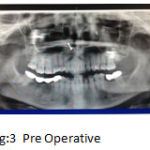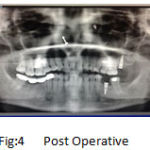Vijay Ebenezer 1, R. Balakrishnan2,Senthil Nathan3
1Vijay Ebenezer, Head of the Department, Department of Oral and Maxillofacial Surgery, Sree Balaji Dental College and Hospital, Bharath University, Pallikaranai, Chennai - 600100 2R.Balakrishnan, Professor, Department of Oral and Maxillofacial Surgery, Sree Balaji Dental College and Hospital, Bharath University, Pallikaranai, Chennai - 600100 3Senthil Nathan, Reader, Department of Oral and Maxillofacial Surgery, Sree Balaji Dental College and Hospital, Bharath University, Pallikaranai, Chennai - 600100
DOI : https://dx.doi.org/10.13005/bpj/733
Abstract
The posterior maxilla is always considered as the difficult site for the placement of implant than the mandible due to the presence of various anatomical land mark such as maxillary sinus , these anatomical structures often makes every dental implant surgeons a challenge task in placement of endosteal implants in the chronic atropic maxilla and difficult in osteointegration and further functional and aesthetic implant supported prosthesis.various techniques in sinus lifting procedure enables the additional anchorage and stability in implants placed support in maxillary segments in with atropic ridges and pneumatic sinuses.
Keywords
Atropic maxilla; sinus floor; crestal approach; osteotome; endoseous implants
Download this article as:| Copy the following to cite this article: Ebenezer V, Balakrishnan R, Nathan S. Indirect Sinus Lift in Immediate Placent of implant –A Case Report. Biomed Pharmacol J 2015;8(October Spl Edition) |
| Copy the following to cite this URL: Ebenezer V, Balakrishnan R, Nathan S. Indirect Sinus Lift in Immediate Placent of implant –A Case Report. Biomed Pharmacol J 2015;8(October Spl Edition). Available from: http://biomedpharmajournal.org/?p=3673> |
Introduction
Implant placement in compromised posterior maxilla is more demanding and essential with available bone quality and quantity for the functional chewing and speech .1-5 the presence of maxillary sinus floor above the maxillary alveolar bone after the extraction limits the implant placement and as the implant perforate the sinus lining and complicate the successful osteointegration of the implant . so various treatment and approaches are available for elevating the sinus floor and lining to achive excess height and primary stability for the placement of root form implants the widely performed two techniques for sinus floor elevation are lateral window approaches 6-8 and .to increase the amount of bone in the atrophic maxilla the sinus lift procedure and subantral augmentation procedure are performed and developed at the mid 1970’s( 7) creastal bone approaches(9-14) .the most commonly used technique for maxillary sinus floor lifting through a lateral window which was first presented by tatum in 1977,and was first published by boyne and james 1980. (14-16). This bone augmentation Is considered as the time consuming invasive and expensive procedure when compared to the minimally invasive methods .summers in 1994 introduced the a less aggrasive procedure for sinus floor elevation with immediate placement of implant known as the osteotomy sinus floor elevation (OSFE)(17). Creastal approach was very widely performed rather than lateral window approach followed by osteotome for elevation of the membrane and floor of the sinus and immediate placement of the implant.at the same time graft mayor may not be placed
This procedure is less invasive compared to the lateral window approach ,less time consuming , mii al trauma to the underlying structures and post operative complications is less and prognosis of the treatment is similar to the usual conventional technique (18)
Materials and Methods
Our study was performed inbetween the age group of 25 to 50years irrespective of genders having poor prognosis of maxillary posterior teeth including root stumps and that are opted for extraction. patients with chronic sinusitis and smokers, long standing chronic nasal obstruction, pregnant patients and psychologically ill patients are excluded from the study.
A preoperative evalution of bone height and bone width are measured clinically and with the help of intro oral radiograph.
1Antibiotic prophylaxis is was initiated a day before surgery
2Under local anaesthesia tooth was extracted , and the surgical curratage done and socket irrigated with betadine solution.
3Drill upto 1 mm away from the floor was was continued with1.1,2.8 ,3.3 drills were used till the final preparation.then the expansion osteotomes are used
4light tapping with a mallet carefully collapse the sinus floor into the sinus cavity elevating the schneiderian membrane.
5elevation of the sinus membrane performed using the 3# osteotome,that was used previously to force the graft head of its tip to achive fracture the sinus floor up fracture.
6implant of dimension of (13 x 4.2 mm) was placed.primary stability was assessed by finger pressure the implant showed primary stability .stability can also be increased by the threads or by placing the implant deeper.
7abutment was positioned over the implant and the occlusal height was adjusted , implant was loaded with temporary restoration.
8post operatively, patient was adviced to rinse the mouth with twice a day with 0.12% of chlorohexidine solution for two weeks after surgery. antibiotics wera priscribed for next 7 days.
9After a healing period of 4 months , patient was recalled , and rehabilitated with fixed prosthesis.
 |
Figure 1: Pre Operative |
 |
Figure 2: Post Operative |
 |
Figure :3 Pre Operative |
 |
Figure 4: Post Operative |
Discusion
The elevation of the maxillary sinus floor was first reported by the boyne in 1960, after fifteen years later boyne and jame reported elevation of the maxillary sinus floor in largely pnuematized sinus cavities in preparation of the placement of the bladed implants. always the decreased bone height in the posterior maxilla limits the placement of the implant , so the problem can be solved by elevating the maxillary sinus and achieving excess height for the placement of implant and so the implant enters into the space occupied by the sinus floor and the ridged fixation is achieved and osteo integration takes place . these authors proposed two different techniques for the easy way to approach the sinus floor without disturbing the integrity of the sinus lining the various two methods that was currents performed are lateral window approach and crestal approach, both the approaches have their own advantages and disadvantages, either with or without placement of the grafts here in this study we a practicing only the easy and the recent approach of crestal approach , because the procedure is invasive , a traumatic and less time consuming procedure , here the alveolar bone that is present in between the sinus floor root apex acts as the readymade graft and it tents the sinus floor so the enough space is created in between the floor and the prepared site so that the root form implants enters the sinus cavity behind the bone , this procedure is widely practised and there is no much complications post operatively, in direct sinus lifting surgery piezo instrument is used to create the window , whereas in crestal approach osteotome is used to elevate the sinus floor the advantage of this procedure is avoidance of the invasive surgery and permitting treatment with a single stage, to achive excellent primary stability in the cases of sinus floor lifting followed by immediate extraction cases use of osteotomies are more useful than using the drills , by compressing the sinus floor slightly by indirect approach with osteotomies can condense the bone laterally dense interface is created in between the sinus and the implant 19. Improving the initial bone to the implant contact 20. Commonly the complications happens if the schneiderian membrane is perforated by the instrumentation and implant and the filling material can move into the sinus cavity and can cause sinusitis 21 and 22, proper case selection and anatomical site preparation can overcome these problems.
Conclusion
Implant placement in in the posterior maxilla that are atrophied with less height in between the sinus floor and the alveolar ridge can be greatly extended by the indirect sinus lift procedure through the crestal osteotome approach as the procedure is very easy and invasive and the time consumption is less and the apical bone themselves acts as the bone graft and that tents the sinus lining and crestal sufficient primary stability for the implant placement with less post-operative complications. It also allows the treating the compromised posterior maxilla with reliable results.
Referenses
- Adell R ,LekholM U ,Rockler B , Brenmark Pi. A 15 – year study of osteointegrated implants in the treatment of the edentulous jaw. Int oral surg1981;10: 387- 416.
- Bryant SR The effect of age , jaw site , and bone condition on oral implants out comes .int j prosthodont 1998:11:470- 90.
- Esposito m, Hirsch JM, Lekholm u, thomsosen p , biological factors contributing to failures of osteo integrated oral implants (i) success criteria and epidermiology, Eur J oral sci 1998;106;527-51.
- sennerby L.roos J. surgical determinants of clinical success of osteo integrated oral implants , A review of the literature int J PROSTHODONTI, 1998:11: 408- 20.
- Truhlar RS .orenstein IH, Morrris IH,Ochi S.distribution of bone quality in patients recievingendosseous dental implants.J. oral maxillofac surg 1997;55:38-45.
- BOYNE pj, james RA. Grafting of the maxillary sinus floor with autogenous marrow and bone, j oral surg1980:38:613-16.
- Jensen J, Sindet-Pedersen S. Autogenous mandibular bone grafts and osseointegrated implants for reconstruction of the severely atrophied maxilla: a preliminary report. J Oral Maxillofac Surg. 1991;49:1277–87. [PubMed].
- Hatano n.shimizu y. ooya K.A Clinicl long term radiographic evalution of graft height changes after maxillary sinus floor augmentation with a 2:1 autogenous bone xenograft mixture and simultaneous placement of dental implants.clin oral implants Res 2004:15:339-45.
- Jensen OT .shulman LB , Block MS.Iacono VJ. Repot of the sinus consenced conference of 1996. Int j oral maxillofacc implants 1998.13(suppl) 11-45.
- summers RB .the osteotome technique prt 3 –less invasive methods of elevating the sinus floor. Compendrum 1994:15:698-702.
- Bragger u. Gerber C. JOSS a, Haenni s,Meier A, Hashorva E et al, patterns of tissue remodelling after placement of iti dental implants using a osteotome technique, A Longitudinal radiographic case cohort study clin oral implants Res 2004,15:158-66
- cavicchiaF . BRAVI f , petrelli G. localized augmentation of the maxillary sinus floor through a coronal approach for the placement of implants int periodontics restorative dent 2001:21;475- 85.
- Rosens PS , Summers R, MellDO JR. Salkim LM, shanaman RH. Marks MH et al the bone added osteotome sinus floorelevation technique, multicentre retrospective report of consecutively treated patients int oral maxillofac implants 1999:14: 853 -58.
- Tantum H jr maxillary and sinus implant reconstructions. Dent clin north AM 1986:30:207-29.
- Emmerich D , Att w. stappert C. sinus floor elevation using osteotomes A systemic review and meta analysis .J periodontal.2005:76:1237-51.
- smiler LB, Jensen OT, Sinus lift grafts and endosseous implants treatment of the atropic posterior maxilla Dent clin North Am 1992: 36:151-88.
- Shulman LB , Jensen OT , Sinus graft consensus conference introduction int J oral maxillofac implants 1998:13(suppl):5-6.
- Raghoebar GM ,timmenga N M, Reintsema stegenga B, Vissink A ,Maxillary bone grafting for insertion of endosseoud implants , results sfter 12 to 124 months , clin oral implants Res 2001:12.279-86.
- Hahn J. Clinical uses of osteotomes . J oral implantol 1999:25:23.
- Nkenke E .Radespiel – troger M .wiltfang J.Schultze mosgau S Winkler G Neukam morbidity of harvesting of retromolar bone grafts. A prospective study. Clin oral implants Res 2002 oct:13(5):514-21.
- Nedir R .Bischof M,Vazquez L, szmukler, monclerS , Bernard i-year prospective piolt studywith iti implants clin oral implants Res 2006:17:679-86.
- pikos MA MaxillARY Membrane repair. Update on technique for large and compete perforations , implant dent 2008:17:24-31.








